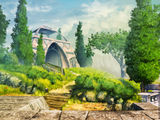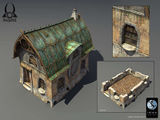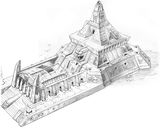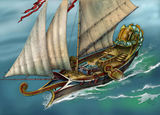Difference between revisions of "Sacred 2:Tyr Lysia"
(links, typo) |
m (moved toc) |
||
| (15 intermediate revisions by 3 users not shown) | |||
| Line 1: | Line 1: | ||
{{Languages}} | {{Languages}} | ||
| − | + | <div style="float:right;"> | |
| + | __TOC__ | ||
| + | </div> | ||
| + | '''Reference:''' [[Sacred 2:Book 1 - Tyr Lysia|Geography of Ancaria, Book 1: Tyr Lysia]] | ||
| + | {| | ||
| + | |[[File:Flag heraldry 001.jpg|x200px]] | ||
| + | |'''Flag of Tyr Lysia''' - Players will see this [[Sacred 2:Heraldry|flag]] flown throughout the region of the High Elves, most frequently in encampments of soldiers. | ||
| + | |} | ||
==Geography and Climate== | ==Geography and Climate== | ||
| Line 24: | Line 31: | ||
Country Elves are simple people, who work the land for their lords. Their homes are functional and comfortable, without being ostentatious. They don't have the luxuries that their city brethren have, but they're also safely removed from much of the strife that occurs. They work hard, but have a good and honest life – as long as their lord is happy and nature doesn't inflict drought or flooding on them. | Country Elves are simple people, who work the land for their lords. Their homes are functional and comfortable, without being ostentatious. They don't have the luxuries that their city brethren have, but they're also safely removed from much of the strife that occurs. They work hard, but have a good and honest life – as long as their lord is happy and nature doesn't inflict drought or flooding on them. | ||
| − | {{S2frame|[http://www.sacredwiki.org/images/Sacred_2/Regions/human_blacksmith_HE.jpg http://www.sacredwiki.org/images/Sacred_2/Regions/th_human_blacksmith_HE.jpg]|none}} | + | {| |
| − | + | |{{S2frame|[http://www.sacredwiki.org/images/Sacred_2/Regions/human_blacksmith_HE.jpg http://www.sacredwiki.org/images/Sacred_2/Regions/th_human_blacksmith_HE.jpg]|none}} | |
| + | |{{S2frame|[http://www.sacredwiki.org/images/Sacred_2/Regions/human_girl_HE.jpg http://www.sacredwiki.org/images/Sacred_2/Regions/th_human_girl_HE.jpg]|none}} | ||
| + | |} | ||
In and near the capital city of Thylysium, the city Elves dominate the population. City Elves don't have feudal masters like their country cousins, and their numbers span the social spectrum ranging from nobility, clergy, merchants and tradesmen. The nobility have town houses here, and the nobles serve in the senate. The clerics serve in the Temple, and generally live close by. As you look at the outlying city, further from the city center, you see more of the dwellings and businesses of the merchants and tradesmen. When you look even further, you'll find the dwellings of the Humans. Most Humans here are slaves, however there also are some enclaves of freed Humans. In both cases, they live on the outskirts of the city in slums and run-down areas. For the slaves that's the best their masters will provide, for the others that's all their Elven landlords will rent to them. | In and near the capital city of Thylysium, the city Elves dominate the population. City Elves don't have feudal masters like their country cousins, and their numbers span the social spectrum ranging from nobility, clergy, merchants and tradesmen. The nobility have town houses here, and the nobles serve in the senate. The clerics serve in the Temple, and generally live close by. As you look at the outlying city, further from the city center, you see more of the dwellings and businesses of the merchants and tradesmen. When you look even further, you'll find the dwellings of the Humans. Most Humans here are slaves, however there also are some enclaves of freed Humans. In both cases, they live on the outskirts of the city in slums and run-down areas. For the slaves that's the best their masters will provide, for the others that's all their Elven landlords will rent to them. | ||
| − | {{S2frame|[ | + | {| |
| − | + | |{{S2frame|[[File:Renders house.jpg|160px]]|none}} | |
| + | |{{S2frame|[[File:Renders High Elf Villa1.jpg|160px]]|none}} | ||
| + | |} | ||
The villages consist of simple houses, the inhabitants are friendly, but not very outgoing around strangers. There are altars and small cult sites in almost every village. They are usually decorated with flowers and grain ears. High Elves believe in a large pantheon of deities. Villages show their wealth through the number and sizes of their altars. Poor villages usually only have one altar that all deities must share. | The villages consist of simple houses, the inhabitants are friendly, but not very outgoing around strangers. There are altars and small cult sites in almost every village. They are usually decorated with flowers and grain ears. High Elves believe in a large pantheon of deities. Villages show their wealth through the number and sizes of their altars. Poor villages usually only have one altar that all deities must share. | ||
==Practices== | ==Practices== | ||
| − | The harvest festival season in the fall almost guarantees that visitors will have a good time. Every village celebrates the festival at a different date so that one can spend weeks traveling from one festival to the other. Houses and huts are decorated with flowers, noblemen open their wine cellars to the public, jugglers, actors, and bards travel the land. Recommendations: Tyr Lysia is suitable for travel all year long, though it can get very hot and dry upcountry in the summer. Visitors should avoid areas with burned down villages, as these are often frequented by the undead which make no difference between locals and travelers. | + | The harvest festival season in the fall almost guarantees that visitors will have a good time. Every village celebrates the festival at a different date so that one can spend weeks traveling from one festival to the other. Houses and huts are decorated with flowers, noblemen open their wine cellars to the public, jugglers, actors, and bards travel the land. The villages and cities of Tyr Lysia are filled with artists who display their [[Sacred 2:Art of Ancaria|paintings]] in the streets and town squares. Recommendations: Tyr Lysia is suitable for travel all year long, though it can get very hot and dry upcountry in the summer. Visitors should avoid areas with burned down villages, as these are often frequented by the undead which make no difference between locals and travelers. |
{{S2frame|[http://www.sacredwiki.org/images/Sacred_2/Regions/chair_HE.jpg http://www.sacredwiki.org/images/Sacred_2/Regions/th_chair_HE.jpg]|none}} | {{S2frame|[http://www.sacredwiki.org/images/Sacred_2/Regions/chair_HE.jpg http://www.sacredwiki.org/images/Sacred_2/Regions/th_chair_HE.jpg]|none}} | ||
| Line 47: | Line 58: | ||
Thylysium lies near a river delta on the west coast of Tyr Lysia, land of the Elves. Because of the Jade Sea the climate is dry, slightly salty, and generally pleasant. In winter there's a likelihood of storms, but floods are rare. | Thylysium lies near a river delta on the west coast of Tyr Lysia, land of the Elves. Because of the Jade Sea the climate is dry, slightly salty, and generally pleasant. In winter there's a likelihood of storms, but floods are rare. | ||
===Architecture=== | ===Architecture=== | ||
| + | {{S2frame|[http://www.sacredwiki.org/images/Sacred_2/Regions/architecture_arc_HE.jpg http://www.sacredwiki.org/images/Sacred_2/Regions/th_architecture_arc_HE.jpg]|none}} | ||
Thylysium is a magnificent city. Even simple houses are made of granite (the construction of wooden houses or mud huts is prohibited by law), townhouses and temples are built with white marble. There are many places one should visit, among them the Academy of Magic, the Senate and the surrounding gardens with their exotic flowers, and the Road of the Aristocrats, a boulevard lined with the largest and most opulent townhouses and mansions. Thylysium is the biggest and greatest city of Ancaria. It is a symbol for the power and dominance of the High Elves, but a closer look also reveals a very good picture of the real state of the realm. | Thylysium is a magnificent city. Even simple houses are made of granite (the construction of wooden houses or mud huts is prohibited by law), townhouses and temples are built with white marble. There are many places one should visit, among them the Academy of Magic, the Senate and the surrounding gardens with their exotic flowers, and the Road of the Aristocrats, a boulevard lined with the largest and most opulent townhouses and mansions. Thylysium is the biggest and greatest city of Ancaria. It is a symbol for the power and dominance of the High Elves, but a closer look also reveals a very good picture of the real state of the realm. | ||
| − | {{S2frame|[ | + | {{S2frame|[[File:SACRED2 art temple.jpg|160px]]|none}} |
The visual style and atmosphere the Elven capital resembles that of the ancient imperial capital cities like Rome. The most humble of buildings are made out of fine materials, and the most important buildings are made from the rarest materials in all of Ancaria. The dark and mystical decorations of the temples are eye-catching, and the countless lines of [[Sacred 2:Book 5 - T-Energy|T-Energy]] in the alleys, that flow through the town like veins in a leaf, are also striking. With the exception of the battle arena and the area where the nobility resides, the town is primarily defined by three central places: City Hall, the Great Temple and the harbor. | The visual style and atmosphere the Elven capital resembles that of the ancient imperial capital cities like Rome. The most humble of buildings are made out of fine materials, and the most important buildings are made from the rarest materials in all of Ancaria. The dark and mystical decorations of the temples are eye-catching, and the countless lines of [[Sacred 2:Book 5 - T-Energy|T-Energy]] in the alleys, that flow through the town like veins in a leaf, are also striking. With the exception of the battle arena and the area where the nobility resides, the town is primarily defined by three central places: City Hall, the Great Temple and the harbor. | ||
| Line 54: | Line 66: | ||
===Citizens=== | ===Citizens=== | ||
The city is governed by the Senate. Among its members are merchants, priests, and noblemen. They are the upper-class of Thylysium and live in large townhouses. Leaving the broad streets one soon comes across an astonishing number of different languages, smells, and faces. People come to Thylysium from all parts of Ancaria, sometimes to trade, sometimes just to satisfy their curiosity. Some are rich, some poor,- there are merchants and laborers, fishermen and thieves. | The city is governed by the Senate. Among its members are merchants, priests, and noblemen. They are the upper-class of Thylysium and live in large townhouses. Leaving the broad streets one soon comes across an astonishing number of different languages, smells, and faces. People come to Thylysium from all parts of Ancaria, sometimes to trade, sometimes just to satisfy their curiosity. Some are rich, some poor,- there are merchants and laborers, fishermen and thieves. | ||
| − | { | + | {| |
| − | + | |[[File:Flag heraldry 005.jpg|120px]] | |
| − | City Hall and the Temple represent the two major powers in Elven society, the nobility and the clerics. They have been fighting each other for centuries, trying to gain leverage in the ongoing struggle for power. Corruption and crime are commonplace. | + | |[[File:Flag heraldry 002.jpg|120px]] |
| − | + | |'''[[Sacred 2:Heraldry|Heraldry]]''' of the '''Thylysium Senate''' and of the '''Inquisition.''' City Hall and the Temple represent the two major powers in Elven society, the nobility and the clerics. They have been fighting each other for centuries, trying to gain leverage in the ongoing struggle for power. Corruption and crime are commonplace. | |
| + | |} | ||
Outside of the power struggle, the large harbor acts as the worldly and logistical center of the city. Travelers who wish to experience real life in Thylysium should visit the harbor where they will meet all kinds of people and see an astonishing selection of goods. It has been said that everything in Ancaria will sooner or later arrive at Thylysium's harbor. After spending a day watching the harbor and eating in one of the many cookshops travelers will most likely agree. The sea is covered in white sails and dark brown wood Barrels are rolled from ships, crates are carried to the markets, bolts of fabric are sold to the highest bidder. Even late in the night one can hear the merchants bargaining and the laborers shouting. Humans, animals, materials, jewelry, food - everything is traded in Thylysium. | Outside of the power struggle, the large harbor acts as the worldly and logistical center of the city. Travelers who wish to experience real life in Thylysium should visit the harbor where they will meet all kinds of people and see an astonishing selection of goods. It has been said that everything in Ancaria will sooner or later arrive at Thylysium's harbor. After spending a day watching the harbor and eating in one of the many cookshops travelers will most likely agree. The sea is covered in white sails and dark brown wood Barrels are rolled from ships, crates are carried to the markets, bolts of fabric are sold to the highest bidder. Even late in the night one can hear the merchants bargaining and the laborers shouting. Humans, animals, materials, jewelry, food - everything is traded in Thylysium. | ||
{{S2frame|[http://www.sacredwiki.org/images/Sacred_2/Regions/house_glass_HE.jpg http://www.sacredwiki.org/images/Sacred_2/Regions/th_house_glass_HE.jpg]|none}} | {{S2frame|[http://www.sacredwiki.org/images/Sacred_2/Regions/house_glass_HE.jpg http://www.sacredwiki.org/images/Sacred_2/Regions/th_house_glass_HE.jpg]|none}} | ||
| Line 71: | Line 84: | ||
Travelers should be aware that a friendly face often hides a drawn dagger. One should also avoid the town guard as its soldiers are known for taking bribes and are often in league with one of the many gangs in town. A clear mind and open eyes are needed in Thylysium. Travelers should be careful when talking to citizens and should trust no stranger. | Travelers should be aware that a friendly face often hides a drawn dagger. One should also avoid the town guard as its soldiers are known for taking bribes and are often in league with one of the many gangs in town. A clear mind and open eyes are needed in Thylysium. Travelers should be careful when talking to citizens and should trust no stranger. | ||
| − | ==Places of Interest | + | ==Places of Interest== |
When visiting Tyr Lysia one should - of course after seeing the capital Thylysium - also travel to two other places. One is [[Sacred 2:Clearview|Clearview]], an unassuming small town blessed with a spectacular view. It lies at the top of a mountain surrounded by smaller hills and plains which on a clear day allow the visitor to see places as far away as the Dragon Teeth to the north and even [[Sacred 2:Bluestone Lake|Bluestone Lake]] to the east. It's a steep ascent to Clearview, but the most spectacular view in all of Tyr Lysia is well worth the exertion. Unfortunately the amount of visitors has also let to an enormous increase in thievery. Keeping a close eye on one's possessions is advised. The other place of interest is called [[Sacred 2:Sonnenwind|Sonnenwind]]. It used to be a simple fishing village at Bluestone Lake, but then aristocrats began building their summer residences there to escape the summer heat. Nowadays nearly ten times as much people live there compared to the time before the arrival of the aristocracy and the village specialty Eye Clam Salad is nowadays renowned in all of Tyr Lysia. | When visiting Tyr Lysia one should - of course after seeing the capital Thylysium - also travel to two other places. One is [[Sacred 2:Clearview|Clearview]], an unassuming small town blessed with a spectacular view. It lies at the top of a mountain surrounded by smaller hills and plains which on a clear day allow the visitor to see places as far away as the Dragon Teeth to the north and even [[Sacred 2:Bluestone Lake|Bluestone Lake]] to the east. It's a steep ascent to Clearview, but the most spectacular view in all of Tyr Lysia is well worth the exertion. Unfortunately the amount of visitors has also let to an enormous increase in thievery. Keeping a close eye on one's possessions is advised. The other place of interest is called [[Sacred 2:Sonnenwind|Sonnenwind]]. It used to be a simple fishing village at Bluestone Lake, but then aristocrats began building their summer residences there to escape the summer heat. Nowadays nearly ten times as much people live there compared to the time before the arrival of the aristocracy and the village specialty Eye Clam Salad is nowadays renowned in all of Tyr Lysia. | ||
| Line 134: | Line 147: | ||
[[Sacred 2:Old Dwarven Pass|Old Dwarven Pass]] | [[Sacred 2:Old Dwarven Pass|Old Dwarven Pass]] | ||
| − | [[Sacred 2:Old | + | [[Sacred 2:Old Naval Port|Old Naval Port]] |
|valign="top"|[[Sacred 2:Sea of Heavens|Sea of Heavens]] | |valign="top"|[[Sacred 2:Sea of Heavens|Sea of Heavens]] | ||
| Line 154: | Line 167: | ||
[[Sacred 2:Teardrop Hamlet|Teardrop Hamlet]] | [[Sacred 2:Teardrop Hamlet|Teardrop Hamlet]] | ||
| − | + | [[Sacred 2:Temple Ruins|Temple Ruins]] | |
| − | [[Sacred 2:The Sleepy Badger|The Sleepy Badger]] | + | |valign="top"|[[Sacred 2:The Sleepy Badger|The Sleepy Badger]] |
[[Sacred 2:Thylysium|Thylysium]] | [[Sacred 2:Thylysium|Thylysium]] | ||
| Line 171: | Line 184: | ||
[[Sacred 2:Villa Boerdijk|Villa Boerdijk]] | [[Sacred 2:Villa Boerdijk|Villa Boerdijk]] | ||
| + | |||
| + | [[Sacred 2:Western Tyr Lysia portal|Western Tyr Lysia Portal]] | ||
|} | |} | ||
| − | |||
| − | [[Sacred 2: | + | ==[[Sacred 2:Bestiary|Bestiary]]== |
| + | The most common enemies in Tyr Lysia are High Elves, Undead, Kobolds, and Wild Animals. There are also monsters like Harpies and Elementals as well as the occasional Ghost. The player may additionally encounter a large number of other enemies through quests (See [[Sacred 2:Quest Bestiary|Quest Bestiary]]). | ||
| + | {|cellpadding=20 | ||
| + | |valign="top"|'''Humanoids''' | ||
| + | |||
| + | [[Sacred 2:Kobold|Kobold]] | ||
| + | |||
| + | [[Sacred 2:Kobold Archer|Kobold Archer]] | ||
| + | |||
| + | [[Sacred 2:Kobold Chief|Kobold Chief]] | ||
| + | |||
| + | [[Sacred 2:Kobold Shaman|Kobold Shaman]] | ||
| + | |||
| + | [[Sacred 2:Kobold Stone Thrower|Kobold Stone Thrower]] | ||
| + | |||
| + | [[Sacred 2:Kobold Warrior|Kobold Warrior]] | ||
| + | |||
| + | |||
| + | '''T-Mutants''' | ||
| + | |||
| + | [[Sacred 2:Mutated Bear|Mutated Bear]] | ||
| + | |||
| + | [[Sacred 2:Mutated Boar|Mutated Boar]] | ||
| + | |||
| + | [[Sacred 2:Mutated Giant Rat|Mutated Giant Rat]] | ||
| + | |||
| + | [[Sacred 2:Mutated Harpy|Mutated Harpy]] | ||
| + | |||
| + | [[Sacred 2:Mutated High Elf|Mutated High Elf]] | ||
| + | |||
| + | [[Sacred 2:Mutated Kobold|Mutated Kobold]] | ||
| + | |||
| + | [[Sacred 2:Mutated Rat|Mutated Rat]] | ||
| + | |||
| + | |valign="top"|'''High Elves''' | ||
| + | |||
| + | [[Sacred 2:Archer of the Bluestone Pirates|Archer of the Bluestone Pirates]] | ||
| + | |||
| + | [[Sacred 2:Archer of the Jade Buccaneers|Archer of the Jade Buccaneers]] | ||
| + | |||
| + | [[Sacred 2:Backstabbing Thief|Backstabbing Thief]] | ||
| + | |||
| + | [[Sacred 2:Brigand|Brigand]] | ||
| + | |||
| + | [[Sacred 2:Captain of the Bluestone Pirates|Captain of the Bluestone Pirates]] | ||
| + | |||
| + | [[Sacred 2:Captain of the Jade Buccaneers|Captain of the Jade Buccaneers]] | ||
| + | |||
| + | [[Sacred 2:Dastardly Bandit|Dastardly Bandit]] | ||
| + | |||
| + | [[Sacred 2:Devious Thief|Devious Thief]] | ||
| + | |||
| + | [[Sacred 2:Inquisition Guard|Inquisition Guard]] | ||
| + | |||
| + | [[Sacred 2:Mage|Mage]] | ||
| + | |||
| + | [[Sacred 2:Malicious Brigand|Malicious Brigand]] | ||
| + | |||
| + | [[Sacred 2:Malicious Thief|Malicious Thief]] | ||
| + | |||
| + | [[Sacred 2:Sailor of the Bluestone Pirates|Sailor of the Bluestone Pirates]] | ||
| + | |||
| + | [[Sacred 2:Seawoman of the Jade Buccaneers|Seawoman of the Jade Buccaneers]] | ||
| + | |||
| + | |valign="top"|'''Animals''' | ||
| + | |||
| + | [[Sacred 2:Black Wolf|Black Wolf]] | ||
| + | |||
| + | [[Sacred 2:Boar|Boar]] | ||
| + | |||
| + | [[Sacred 2:Brown Bear|Brown Bear]] | ||
| + | |||
| + | [[Sacred 2:Cellar Rat|Cellar Rat]] | ||
| + | |||
| + | [[Sacred 2:Dark Rodent|Dark Rodent]] | ||
| + | |||
| + | [[Sacred 2:Giant Bat|Giant Bat]] | ||
| + | |||
| + | [[Sacred 2:Heavy Turtle|Heavy Turtle]] | ||
| + | |||
| + | [[Sacred 2:Large Cellar Rat|Large Cellar Rat]] | ||
| + | |||
| + | [[Sacred 2:Rat|Rat]] | ||
| + | |||
| + | [[Sacred 2:Rodent|Rodent]] | ||
| + | |||
| + | [[Sacred 2:Small Snapper|Small Snapper]] | ||
| + | |||
| + | [[Sacred 2:Spider|Spider]] | ||
| + | |||
| + | [[Sacred 2:Wild Boar|Wild Boar]] | ||
| + | |||
| + | [[Sacred 2:Wolf|Wolf]] | ||
| + | |||
| + | |valign="top"|'''Undead | ||
| + | |||
| + | [[Sacred 2:Ghoul|Ghoul]] | ||
| + | |||
| + | [[Sacred 2:Mummy|Mummy]] | ||
| + | |||
| + | [[Sacred 2:Skeleton Archer|Skeleton Archer]] | ||
| + | |||
| + | [[Sacred 2:Skeleton Mage|Skeleton Mage]] | ||
| + | |||
| + | [[Sacred 2:Skeleton Warrior|Skeleton Warrior]] | ||
| + | |||
| + | [[Sacred 2:Undead Auxillar|Undead Auxillar]] | ||
| + | |||
| + | [[Sacred 2:Undead Centurion|Undead Centurion]] | ||
| + | |||
| + | [[Sacred 2:Undead Legion Mage|Undead Legion Mage]] | ||
| + | |||
| + | [[Sacred 2:Undead Legionnaire|Undead Legionnaire]] | ||
| + | |||
| + | [[Sacred 2:Undead Reservist|Undead Reservist]] | ||
| + | |||
| + | [[Sacred 2:Undead Tribune|Undead Tribune]] | ||
| + | |||
| + | [[Sacred 2:Zombie|Zombie]] | ||
| + | |||
| + | |valign="top"|'''Monsters''' | ||
| + | |||
| + | [[Sacred 2:Elite Harpy|Elite Harpy]] | ||
| + | |||
| + | [[Sacred 2:Harpy|Harpy]] | ||
| + | |||
| + | [[Sacred 2:Lightning Harpy|Lightning Harpy]] | ||
| + | |||
| + | [[Sacred 2:Small Earth Elemental|Small Earth Elemental]] | ||
| + | |||
| + | [[Sacred 2:Small Toxic Elemental|Small Toxic Elemental]] | ||
| + | |||
| + | |||
| + | '''Other''' | ||
| + | |||
| + | [[Sacred 2:Ghost|Ghost]] | ||
| + | |||
| + | [[Sacred 2:Traps|Traps]] (Most types) | ||
| + | |||
| + | |valign="top"|'''Bosses''' | ||
| + | |||
| + | [[Sacred 2:Daloriel the Depraved|Daloriel the Depraved]] | ||
| + | |||
| + | [[Sacred 2:Dragon (DM quest)|Dragon (DM quest)]] | ||
| + | |||
| + | [[Sacred 2:Gahanka|Gahanka]] | ||
| + | |||
| + | [[Sacred 2:Terus, General of the Undead Legion|General Terus]] | ||
| + | |||
| + | [[Sacred 2:Kastagir|Kastagir]] ([[Sacred 2:Community Patch|CM Patch]] Only) | ||
| + | |||
| + | [[Sacred 2:The White Griffin|The White Griffin]] | ||
| + | |} | ||
| + | |||
| + | |||
| + | |||
| + | |||
| − | [ | + | Back to [[Sacred 2:Regions of Ancaria|Regions]] |
Latest revision as of 05:02, 3 March 2014
Reference: Geography of Ancaria, Book 1: Tyr Lysia
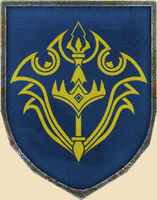
|
Flag of Tyr Lysia - Players will see this flag flown throughout the region of the High Elves, most frequently in encampments of soldiers. |
Geography and Climate
Tyr Lysia, land of the High Elves lies south of the barren Western and Eastern Dragon Teeth and north of the deserts of Bengaresh. It is a fertile and mild land rich in rivers and streams, guarded by fortresses. Villages are surrounded by small fields, birds nest in green hedges. The woods offer rich game. Picturesque fishing villages line the coast in the west. The climate is generally mild, but it can get rather hot in summer, except for the west where a constant cool breeze attenuates the power of the sun. During the summer season there is a chance of extended drought periods, although famines are almost unheard of. The playable characters the High Elf and the Inquisitor hail from this Region.
|
| ||
This region has small villages in a Mediterranean climate. It is a pleasant countryside, with cultivated fields and small woods with leafy green trees, while the village centers are sun-baked and a bit dusty. The common Elves live in simple houses in the countryside or in villages. The nobility live in castles. However, there are a few areas where the fields have been burned and the villages destroyed. The fields here will be tilled in strips, with some earmarked for the peasants, and some for the masters.
|
| ||
Overall, the terrain is very gentle and easy to traverse. Most of the land is flat or at most populated by gently inclining hills, however there are some areas where you need to follow the path. These are mostly found at the borders of the High Elf region, which probably contributed to the original formation of the regions, or near the beach by the sea.
|
| ||
This is quite possibly the most pleasant region of Ancaria. The climate is just right for greenery to abound! In the capital, and to a lesser degree the other cities and villages, you'll see beautifully landscaped trees, shrubbery and flowers, with the occasional palm tree thrown in to add an extra air of opulence. In the outlying areas you'll find farms, vineyards, and rolling meadows dotted with deciduous trees.
|
| ||
As you would expect in a region this inviting, wildlife is abundant. Near the sea, ponds, rivers and streams you'll encounter wildlife such as turtles, frogs and fish. Inland the wildlife is typical of this type of climate and terrain, so you'll meet a variety of wildlife ranging from deer down to rabbits. In cities and villages it's not at all uncommon to run into animals that have been domesticated over the years, and now serve as pets or livestock.
Inhabitants
The dominant race here is that of the Elves, who live in a feudal society where most of the Elves are commoners and serfs, with a privileged nobility ruling over them. Farmers, fishermen, and craftsmen are governed by both nobility and the clergy who lease land and collect taxes (usually food, goods or money.
You'll find two main types of High Elves in this region, city Elves and country Elves.
Country Elves are simple people, who work the land for their lords. Their homes are functional and comfortable, without being ostentatious. They don't have the luxuries that their city brethren have, but they're also safely removed from much of the strife that occurs. They work hard, but have a good and honest life – as long as their lord is happy and nature doesn't inflict drought or flooding on them.
|
| ||||||||||||||||||
In and near the capital city of Thylysium, the city Elves dominate the population. City Elves don't have feudal masters like their country cousins, and their numbers span the social spectrum ranging from nobility, clergy, merchants and tradesmen. The nobility have town houses here, and the nobles serve in the senate. The clerics serve in the Temple, and generally live close by. As you look at the outlying city, further from the city center, you see more of the dwellings and businesses of the merchants and tradesmen. When you look even further, you'll find the dwellings of the Humans. Most Humans here are slaves, however there also are some enclaves of freed Humans. In both cases, they live on the outskirts of the city in slums and run-down areas. For the slaves that's the best their masters will provide, for the others that's all their Elven landlords will rent to them.
|
| ||||||||||||||||||
The villages consist of simple houses, the inhabitants are friendly, but not very outgoing around strangers. There are altars and small cult sites in almost every village. They are usually decorated with flowers and grain ears. High Elves believe in a large pantheon of deities. Villages show their wealth through the number and sizes of their altars. Poor villages usually only have one altar that all deities must share.
Practices
The harvest festival season in the fall almost guarantees that visitors will have a good time. Every village celebrates the festival at a different date so that one can spend weeks traveling from one festival to the other. Houses and huts are decorated with flowers, noblemen open their wine cellars to the public, jugglers, actors, and bards travel the land. The villages and cities of Tyr Lysia are filled with artists who display their paintings in the streets and town squares. Recommendations: Tyr Lysia is suitable for travel all year long, though it can get very hot and dry upcountry in the summer. Visitors should avoid areas with burned down villages, as these are often frequented by the undead which make no difference between locals and travelers.
|
| ||
The Elves use Humans as servants, and are highly prejudiced against them – they don’t view Humans as property, exactly, but neither do they believe that Humans are capable of advanced thought or civilization. The attitude of both the common Elves and the nobility towards the Humans is similar to the traditional attitude towards the “untouchable” caste in India. Humans serve the noblemen in their mansions or work as farm hands in rural areas. Only rarely does one come upon a Human craftsman. Most Humans are servile, however some (mostly free Humans) tend to be brazen and rude- One should avoid them as they tend to combine stories about their unjust fate with begging.
A long way from here, the Elves have built a wall to keep the Humans in the Human territory. Nevertheless, some Humans come across the border, mostly imported as servants or laborers to do the work that the Elves consider to be beneath themselves. Humans can become free, but they will never be regarded as “equal.” Where free Humans have gathered in small settlements consisting of a few huts, they continue to be the victims of prejudice and occasional attacks, and they know they will never receive justice under the law.
|
| ||
The most visible current conflict is between the Elven nobility and the clergy, each of which has armed forces traveling across the countryside fighting each other. The armies are a hardship on the people and the land. They trample the fields and rob the peasants of their animals and food.
Elven Capital (Thylysium)
Thylysium lies near a river delta on the west coast of Tyr Lysia, land of the Elves. Because of the Jade Sea the climate is dry, slightly salty, and generally pleasant. In winter there's a likelihood of storms, but floods are rare.
Architecture
|
| ||
Thylysium is a magnificent city. Even simple houses are made of granite (the construction of wooden houses or mud huts is prohibited by law), townhouses and temples are built with white marble. There are many places one should visit, among them the Academy of Magic, the Senate and the surrounding gardens with their exotic flowers, and the Road of the Aristocrats, a boulevard lined with the largest and most opulent townhouses and mansions. Thylysium is the biggest and greatest city of Ancaria. It is a symbol for the power and dominance of the High Elves, but a closer look also reveals a very good picture of the real state of the realm.
|
| ||
The visual style and atmosphere the Elven capital resembles that of the ancient imperial capital cities like Rome. The most humble of buildings are made out of fine materials, and the most important buildings are made from the rarest materials in all of Ancaria. The dark and mystical decorations of the temples are eye-catching, and the countless lines of T-Energy in the alleys, that flow through the town like veins in a leaf, are also striking. With the exception of the battle arena and the area where the nobility resides, the town is primarily defined by three central places: City Hall, the Great Temple and the harbor.
Citizens
The city is governed by the Senate. Among its members are merchants, priests, and noblemen. They are the upper-class of Thylysium and live in large townhouses. Leaving the broad streets one soon comes across an astonishing number of different languages, smells, and faces. People come to Thylysium from all parts of Ancaria, sometimes to trade, sometimes just to satisfy their curiosity. Some are rich, some poor,- there are merchants and laborers, fishermen and thieves.
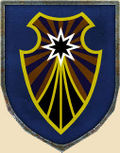
|
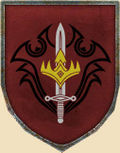
|
Heraldry of the Thylysium Senate and of the Inquisition. City Hall and the Temple represent the two major powers in Elven society, the nobility and the clerics. They have been fighting each other for centuries, trying to gain leverage in the ongoing struggle for power. Corruption and crime are commonplace. |
Outside of the power struggle, the large harbor acts as the worldly and logistical center of the city. Travelers who wish to experience real life in Thylysium should visit the harbor where they will meet all kinds of people and see an astonishing selection of goods. It has been said that everything in Ancaria will sooner or later arrive at Thylysium's harbor. After spending a day watching the harbor and eating in one of the many cookshops travelers will most likely agree. The sea is covered in white sails and dark brown wood Barrels are rolled from ships, crates are carried to the markets, bolts of fabric are sold to the highest bidder. Even late in the night one can hear the merchants bargaining and the laborers shouting. Humans, animals, materials, jewelry, food - everything is traded in Thylysium.
|
| ||
But where there is light, there's also shadow... Away from the city center of the nobles and clerics, Human slaves live in a separate quarter. In a striking contrast to the opulence of the rest of the city, the Human quarter is dirty and composed of ramshackle buildings made of the meanest materials.
Customs
There is only one day without trade in Thylysium. On the Day of Contemplation no ship may enter the harbor and all shops remain closed From sunrise until sunset the city belongs to the Gods. Pilgrims walk between the temples to honor each and every God. Priests smear ashes on their face or walk by swinging jars with burning incense. The city is filled with the chants and songs of the believers,- there is dancing, singing, and meditating. Until sunset no coin may change hands and no business may be conducted The citizens of Thylysium hold this day in such high regard that even thieves respect it and guards refuse to be bribed.
|
| ||
To a visitor it would appear that the city center is safest – as you leave it's civility you'll often see more fights and criminal activity. This is especially true near the docks, where many fights break out as the sailors get drunk and ancient prejudices emerge. Looks can be deceiving though. There is an ongoing power struggle between the nobility and the clerics. They care a great deal about appearances, so there's no visible armed conflict – instead the struggle is conducted in secret. Furtive messengers sneaking about, assassination attempts, poisonings... These are the things a knowledgeable observer can spot with a trained eye.
Travelers should be aware that a friendly face often hides a drawn dagger. One should also avoid the town guard as its soldiers are known for taking bribes and are often in league with one of the many gangs in town. A clear mind and open eyes are needed in Thylysium. Travelers should be careful when talking to citizens and should trust no stranger.
Places of Interest
When visiting Tyr Lysia one should - of course after seeing the capital Thylysium - also travel to two other places. One is Clearview, an unassuming small town blessed with a spectacular view. It lies at the top of a mountain surrounded by smaller hills and plains which on a clear day allow the visitor to see places as far away as the Dragon Teeth to the north and even Bluestone Lake to the east. It's a steep ascent to Clearview, but the most spectacular view in all of Tyr Lysia is well worth the exertion. Unfortunately the amount of visitors has also let to an enormous increase in thievery. Keeping a close eye on one's possessions is advised. The other place of interest is called Sonnenwind. It used to be a simple fishing village at Bluestone Lake, but then aristocrats began building their summer residences there to escape the summer heat. Nowadays nearly ten times as much people live there compared to the time before the arrival of the aristocracy and the village specialty Eye Clam Salad is nowadays renowned in all of Tyr Lysia.
Full List of Places
| Abandoned Mine | Clearview | Happy Cow Farm | Sea of Heavens | The Sleepy Badger |
Bestiary
The most common enemies in Tyr Lysia are High Elves, Undead, Kobolds, and Wild Animals. There are also monsters like Harpies and Elementals as well as the occasional Ghost. The player may additionally encounter a large number of other enemies through quests (See Quest Bestiary).
| Humanoids
|
High Elves
Archer of the Bluestone Pirates Captain of the Bluestone Pirates Captain of the Jade Buccaneers |
Animals | Undead | Monsters
Traps (Most types) |
Bosses |
Back to Regions
